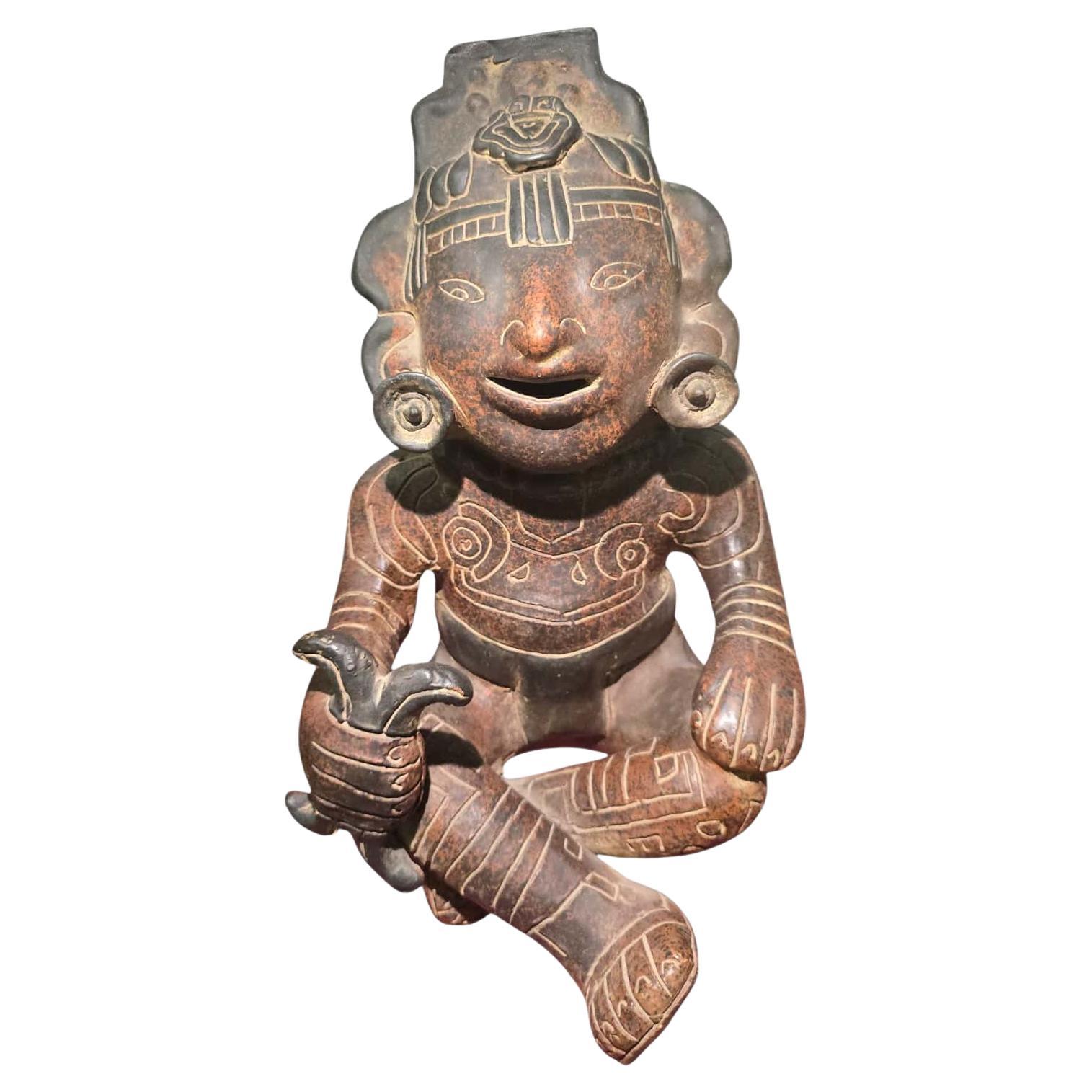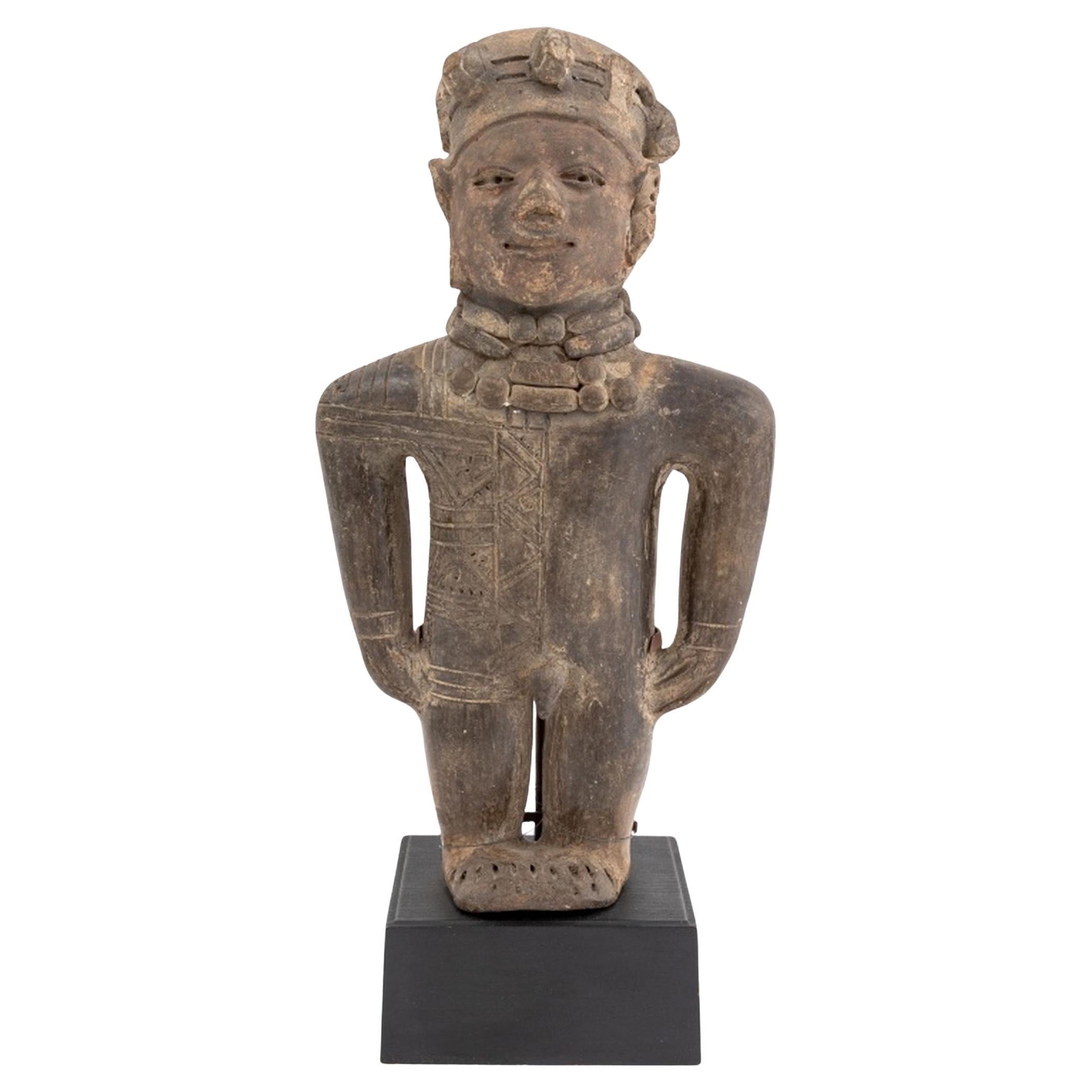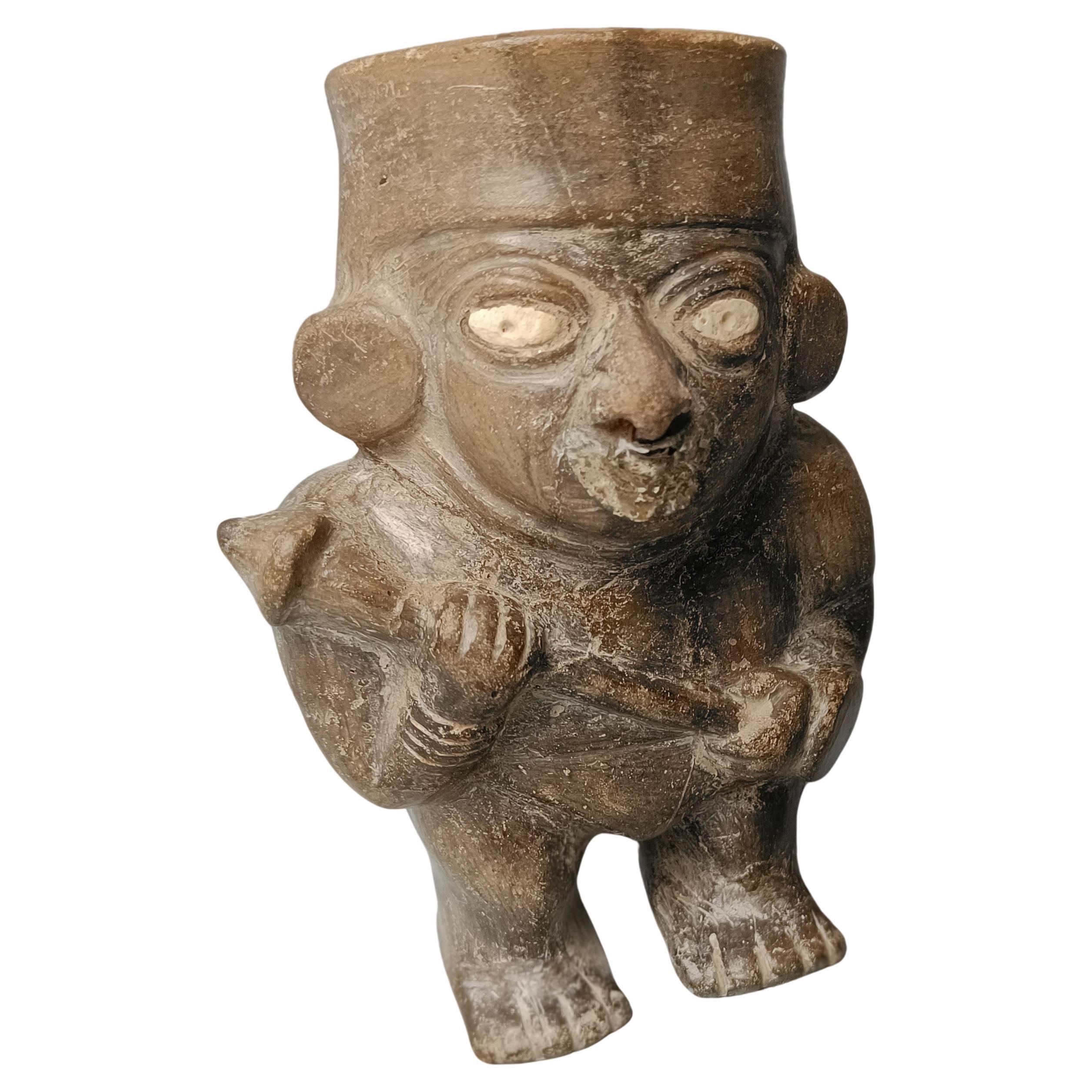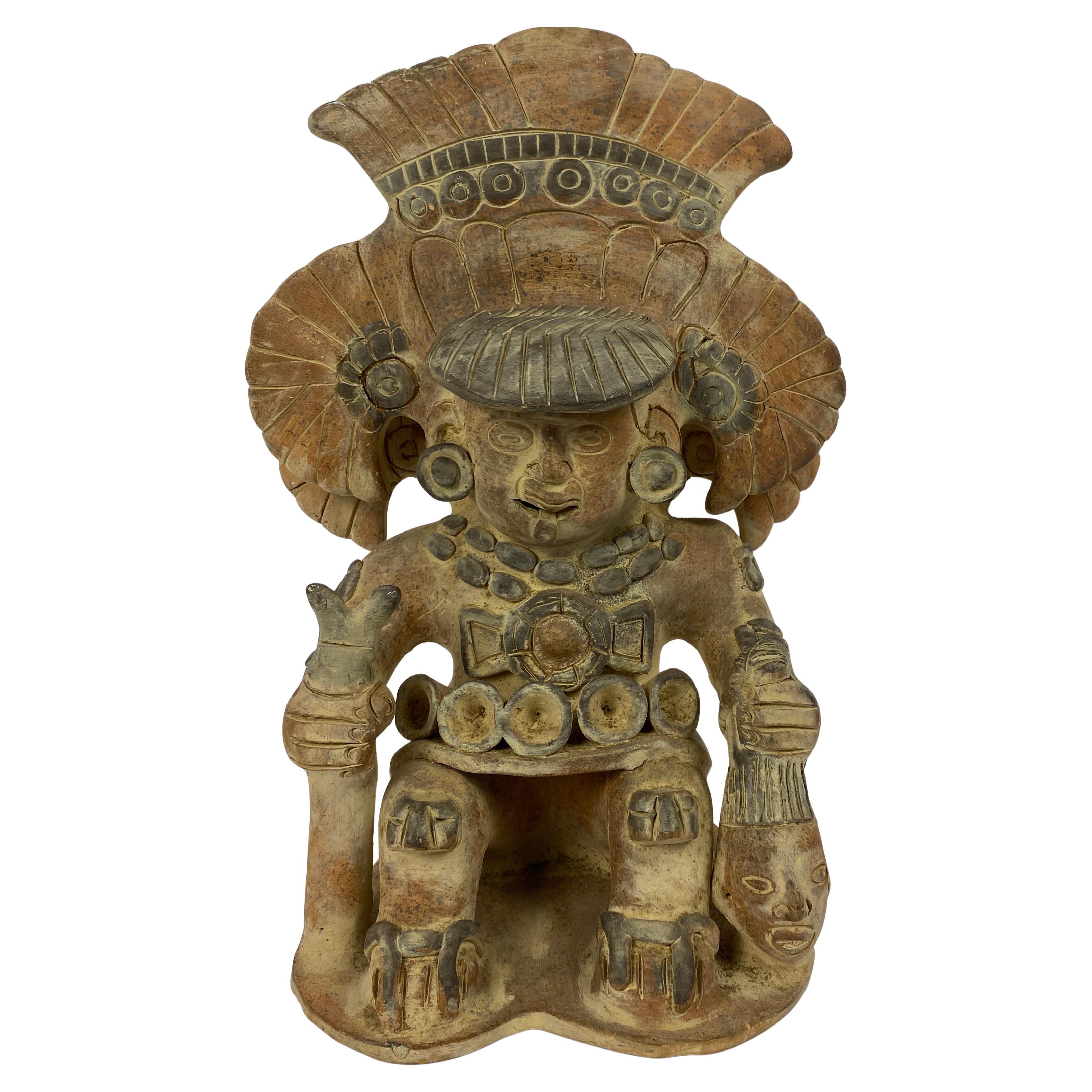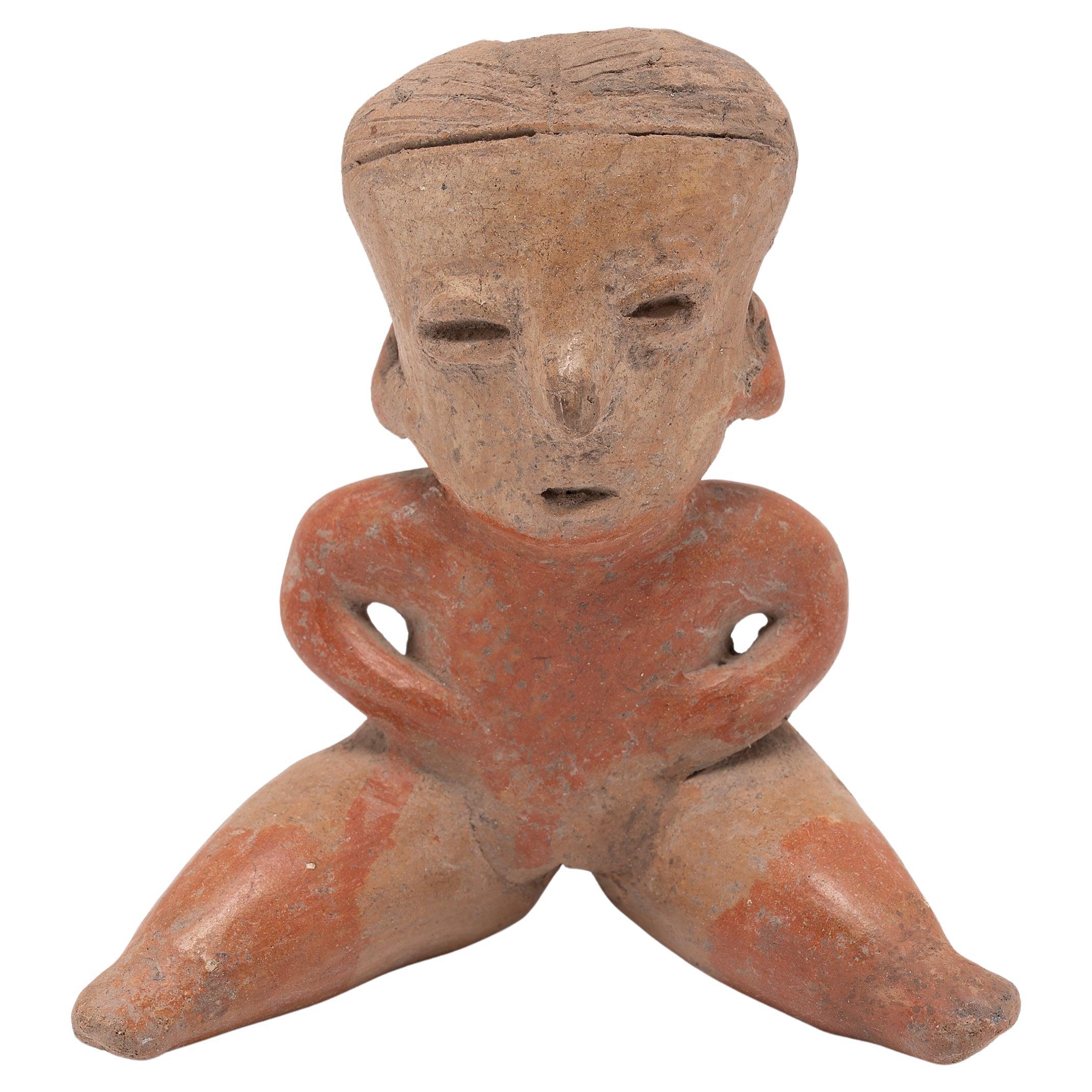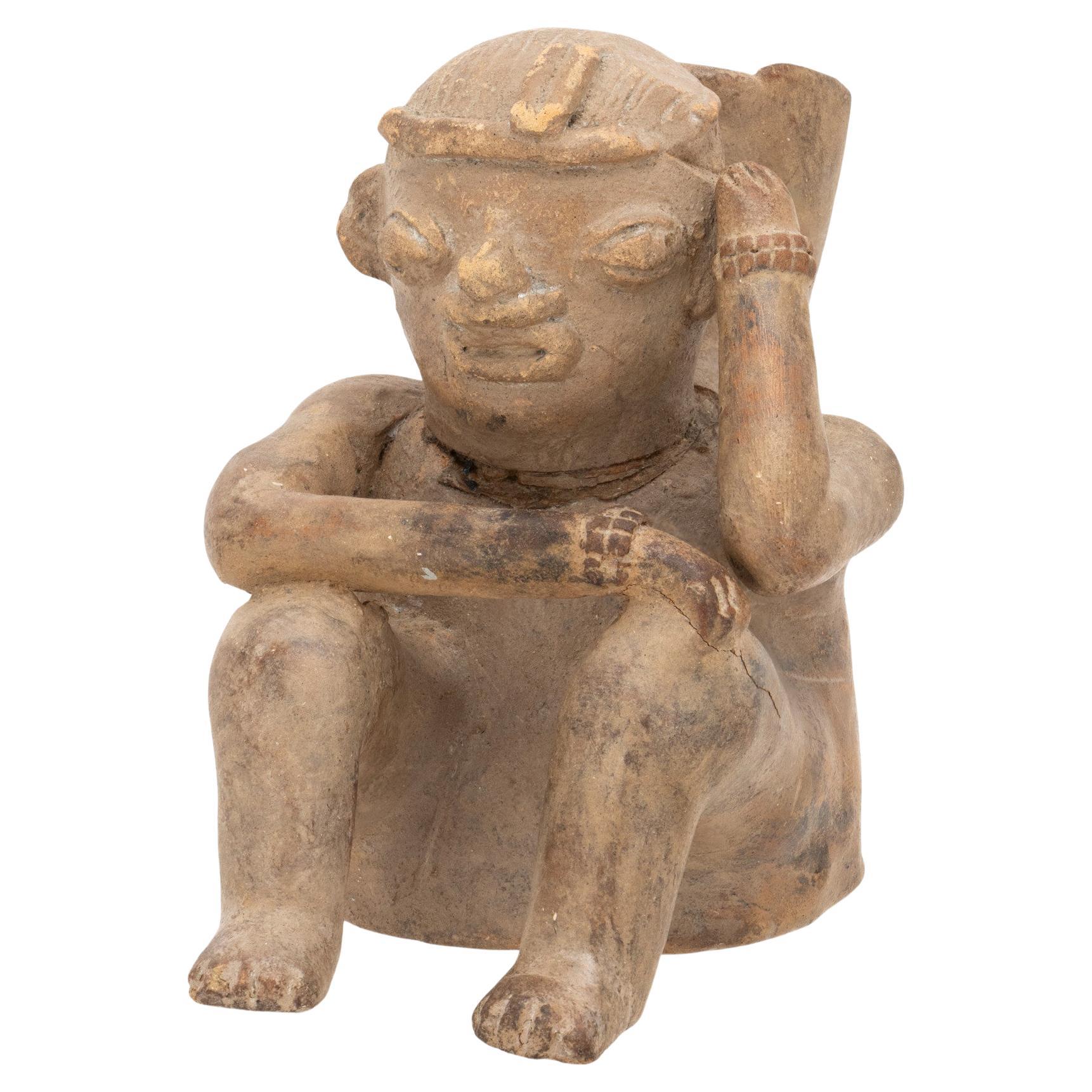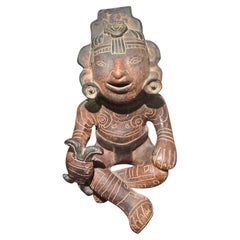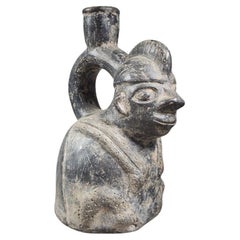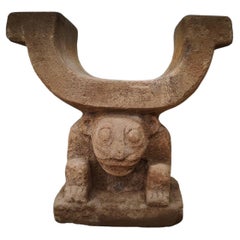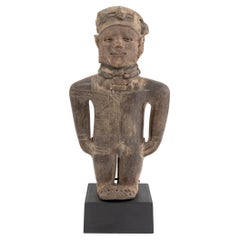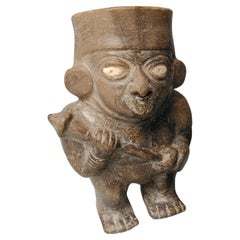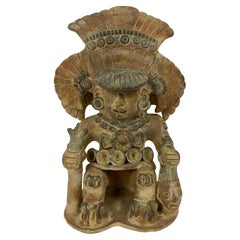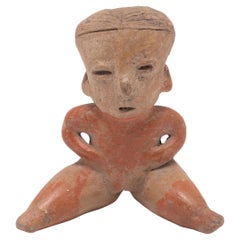Items Similar to Important Olmec figure of Olmec ethnic dignitary from the preclassic period
Want more images or videos?
Request additional images or videos from the seller
1 of 15
Important Olmec figure of Olmec ethnic dignitary from the preclassic period
$18,497.13
£13,724.96
€15,450
CA$25,834.02
A$28,017.60
CHF 14,715.91
MX$340,323.15
NOK 184,146.33
SEK 173,384.05
DKK 117,651.83
About the Item
Important Olmec figure of Olmec ethnic dignitary from the preclassic period (2500-200 BC)
Important Olmec figure of dignitary of the Olmec ethnic group of the preclassic period (2500-200 BC)
Green serpentine, white, yellow veins, shiny surface.
Height 24.5 cm. Weight: 1446 g
Large character sculpted in a magnificent greenish blue serpentine veined with white. He is standing with his legs slightly bent. His arms hang along the trunk, the hands are represented with folded fingers closed by two straight thumbs. His heavy round shoulders are surmounted by a head with a prognathous chin, the lips drawn in the pure Olmec tradition (upper lip down). Two small, hollow, almond-shaped eyes surround a long, aquiline nose with flaring nostrils. On the sides, the presence of rectangular ears.
This statue is exceptional for its size, for the force that emerges from it and finally for its exceptional state of preservation. The Olmec civilization, more concerned with the gods than with men, is not characterized by representations of the human body. This excellently crafted anthropomorphic sculpture displays well-represented anatomical details. Therefore, we should not think that it is a free representation of the human body. On the contrary, it is almost certain that this piece was used in a ritual to represent a god or to attach the attributes of some deities such as necklaces or ornaments. It is dated to the Middle Preclassic for obvious stylistic reasons. This piece is an excellent example of Olmec stone art.
Among some of its physical characteristics, the following stand out: apparently “it had two fleshy bulges on the sides of the nose. The almond-shaped eyes are large and slightly oblique, with the outer corners down;
THE PEOPLE OF THE JAGUAR.
More than 3,000 years ago, between 1,200 and 400 B.C., Mesoamerica saw the rise and fall of the Olmec culture, one of the great civilizations of ancient Mexico. The Olmecs, “those who inhabit the land of rubber”, were capable of collecting and synthesizing the cultural patterns that had developed in the area for centuries. Even after the fall of its great centers, its achievements would be an important part of Mesoamerican culture.
Among the contributions that have led to the consideration of the Olmec as the "mother culture" of Mesoamerica are the first ceremonial buildings built according to a well-determined plan; the social structure, capable of organizing large works; the first and well-defined artistic style, embodied in small objects as well as in colossal sculptures; mastery of carving very hard stones; a fundamental ritual: the ball game; as well as the development of calendrical and writing systems.
The humid lands of southern Veracruz and western Tabasco were the setting where the Olmec culture expressed itself most intensely. Most of the known monumental sculpture—colossal heads, altars or thrones, stelae, and other stone-carved monuments—was found in that region. In a period of little more than 800 years (between 1200 and 400 B.C.), in this rich environment the most important Olmec sites that are known today arose, developed and finally decayed, such as San Lorenzo, Laguna de los Cerros, La Sale and Three Zapotes. Although the precise number of archaeological sites in the area is not yet known, the Olmec population density was quite high. Most of the populations were located on low hills or plateaus, close to rivers, which allowed immediate access to the fertile floodplains.
ORIGIN:
Acquired by the Valdivielso family in the 1960s.
Inherited to his children
Exhibitions:Grisalla Valladolid Art Gallery
BIBLIOGRAPHY.
Alcina Franch, Jose. ARCHAEOLOGISTS OR ANTIQUE DEALERS, Ancient History of Archeology in Spanish America, Ediciones del Serbal, 1995.
De la Fuente, Beatriz. "THE MEN OF STONE, OLMEC SCULPTURE", National Autonomous University of Mexico, Mexico, 1977.
Medellin Zenil, Alfonso. CORPUS ANTIQUITATUM AMERICANENSIUM, "Olmec monoliths and others in the museum of the University of Veracruz", National Institute of Anthropology and History, International Academic Union, Mexico, 1971.
Figures de Pierre, Paris, 1992, fig. 3, p. 31. Mezcala, Carlo Gay and Frances Pratt, Geneva, 1992, p. 213, fig. 253.
L'Art Précolombien, Olmèque, Maya, Aztèque, Lausanne, 1997, p. 76.
Mexico Terre des Dieux, Genève, 1998, p.34, plate 15.
Chontal, Ancient stone sculpture from Guerrero Mexico, Geneva, 2001, p. 109, plate n°164.
Au coeur de l'Amérique Précolombienne, 2003, p. 64, fig. 9. Catalog de la Vente Binoche, March 14, 2005, lot n°8.
Exhibition "Figures de Pierre, L'Art du Guerrero", Paris, 1992. Mexico, Terre des Dieux, Genève, 1998.
Museum of Anthropology of Xalapa, Veracruz. Mexico.
- Dimensions:Height: 2.76 in (7 cm)Width: 3.55 in (9 cm)Depth: 9.45 in (24 cm)
- Materials and Techniques:
- Period:
- Date of Manufacture:200
- Condition:
- Seller Location:Madrid, ES
- Reference Number:1stDibs: LU5779235213582
About the Seller
4.8
Platinum Seller
Premium sellers with a 4.7+ rating and 24-hour response times
Established in 2005
1stDibs seller since 2021
377 sales on 1stDibs
Typical response time: <1 hour
- ShippingRetrieving quote...Shipping from: Madrid, Spain
- Return Policy
Authenticity Guarantee
In the unlikely event there’s an issue with an item’s authenticity, contact us within 1 year for a full refund. DetailsMoney-Back Guarantee
If your item is not as described, is damaged in transit, or does not arrive, contact us within 7 days for a full refund. Details24-Hour Cancellation
You have a 24-hour grace period in which to reconsider your purchase, with no questions asked.Vetted Professional Sellers
Our world-class sellers must adhere to strict standards for service and quality, maintaining the integrity of our listings.Price-Match Guarantee
If you find that a seller listed the same item for a lower price elsewhere, we’ll match it.Trusted Global Delivery
Our best-in-class carrier network provides specialized shipping options worldwide, including custom delivery.More From This Seller
View AllLarge Decorative Pre-Columbian Style Figure – 20th Century
Located in Madrid, ES
Impressive Pre-Columbian style figure from the 20th century, crafted in homage to ancient Mesoamerican art. The piece showcases stylized facial features and traditional ornamentation...
Category
Vintage 1950s Figurative Sculptures
Materials
Terracotta
Stone Carved Anthropomorphic Sculpture From The Recuay Culture Peru 400bc-400ac
Located in Madrid, ES
ANTHROPOMORPHIC SCULPTURE CARVED IN STONE OF THE RECUAY CULTURE PERU 400BC-400AC
Recuay is an archaeological culture of Ancient Peru that developed in the Sierra of the current Peruvian department of Áncash between 200 AD. C. until 600 d. C. It corresponds to the stage called Regional Developments, it has also been called the Huaylas or Santa culture.
Like the other Early Intermediate cultures, little is known about this culture. The most accepted position is that it was an extension of the Chavin culture, after the influence of the "White on Red" style in the region. Regarding the political aspect of the recuay, there is a hypothesis that questions their autonomy and maintains that Recuay would be part of one of the many political units that made up the Moche state.
The recuay style, characterized by its ceramics and stone sculpture, was initially described by Eduard Seler in 1893, based on ceramic specimens brought to the Ethnographic Museum in Berlin by Mariano M. Macedo. Seler named this style of pottery Recuay, based on the report that these pieces had been found in the town of Recuay. Later studies showed that this characteristic pottery was not originally from Recuay but from Copa, near Carhuaz, for which reason the name change to that of this town was proposed. Eventually the name of Huaylas was used for this culture. In 1919 Julio C. Tello explored the area and recovered lithic sculptures and Recuay-type ceramics. In the 1960s Rafael Larco Hoyle proposed changing the names of Recuay and Copa to Santa, arguing that the Recuay style had originated in the coastal regions of the Santa Valley. However, the name Recuay has persisted.
Its chronology is also highly debatable. The time of its origin between 0 and 200 AD is discussed. C. and its end or collapse is commonly set to 600 d. C. probably caused by the invasion of the Huari conquerors.
It encompassed almost the entire Callejón de Huaylas, a narrow valley fed by the Santa River and enclosed between two mountain ranges, the Cordillera Blanca to the west and the Cordillera Negra to the east. Its influence extended to the east to the Marañón river basin and to the west to the upper parts of the Santa, Casma and Huarmey valleys. To the north it reached the town of Pashash, in the province of Pallasca.
The Copa area, Marca district, Recuay province, Ancash department seems to have been the center or main nucleus of cohesion of this culture. The name of the culture would then be justified, derived from the province of the same name. Other important settlements were those of Huilcahuaín (near the current city of Ancash), Cátac, Araucay, Tambo, Jancu, Upayacu and Pashash (near the current city of Cabana).
Its main form of expression of art was through stone work (carving and masonry), inherited from its predecessor, the Chavín culture. In addition, they made sculptures in lumps that represent warriors with shields or trophy heads, with which they decorated their complex architectural constructions. They also made white clay pottery...
Category
Antique 15th Century and Earlier Figurative Sculptures
Materials
Stone
Pre-Columbian Chavín vessel, 900 BC – 300 BC.
Located in Madrid, ES
Pre-Columbian vessel from the Chavín culture in the form of a seated man, probably a hunter, with an animal on his back.
Chavín art is known for its complex iconography and mythical ...
Category
Antique 15th Century and Earlier South American Tribal Ceramics
Materials
Earthenware
Manteña Chair of Power Cachique of Prehispanic Ecuador 900 AD
Located in Madrid, ES
MANTEÑA CHAIR OF POWER CACHIQUE OF PREHISPANIC ECUADOR
The chair has been carved from a block of
detrital sedimentary rock, in which fossil remains can be seen. It is a calcarenite o...
Category
Antique 15th Century and Earlier Animal Sculptures
Materials
Stone
Large Shipibo vase in Peruvian argile – Début of the 20th century
Located in Madrid, ES
Superb vase in traditional argile, made by the Shipibo-Conibo artisans of the Ucayali region in Pérou, at the debut of the 20th century. Ce se présente des motifs caractéristiques de...
Category
Vintage 1940s Figurative Sculptures
Materials
Terracotta
Pre-Columbian Ceramics – Titicaca Culture
Located in Madrid, ES
"Pre-Columbian Ceramics – Titicaca Culture"
Material: Ceramic
Origin: Southern Sierra of Peru, Lake Titicaca Plateau
Period: Boom Age (1 AD – 800 AD)
Dimensions: 15 x 14 cm in diame...
Category
Antique 15th Century and Earlier South American Tribal Ceramics
Materials
Ceramic
You May Also Like
Pre-Columbian Standing Male Nude Figure
Located in Astoria, NY
Pre-Columbian Standing Male Nude Figure, probably Aztec, black burnished terracotta, mounted on ebonized wood base. 14.5" H x 7" W x 4.5" D. Provenance: From an Upper East Side Colle...
Category
Antique 15th Century and Earlier Central American Pre-Columbian Figurati...
Materials
Terracotta
Pre Columbian Rare Moche Warrior Vessel South Latin American Antiques Art
Located in London, GB
Pre-Columbian Moche Warrior Vessel – Moche V Period, 600–700 AD, Peru
A striking and rare example of Moche ceramic artistry, this Pre-Columbian greyware warrior vessel dates from th...
Category
Antique 15th Century and Earlier Peruvian Antiquities
Materials
Pottery
$914 Sale Price
30% Off
Pre-Columbian Style Mexican Terracotta Statue, Molded Clay Figurative Sculpture
Located in Miami, FL
Vintage, decorative and well-proportioned Mexican primitive figure depicting a man seated, with detailed, patterned clothing. The sculpture measures
16 1/4" High x 12" wide x 9 1/2"...
Category
20th Century Mexican Pre-Columbian Figurative Sculptures
Materials
Clay
$1,520 Sale Price
20% Off
Nayarit Chinesco-Style Figure
Located in Chicago, IL
This seated effigy figure was crafted in 300 BC to 300 AD from the ancient Nayarit region of Mexico and was likely used as a ritual or burial offering. The ceramic works of the Chine...
Category
Antique 15th Century and Earlier Mexican Pre-Columbian Figurative Sculpt...
Materials
Ceramic
Pre-Columbian Central Mexico Pottery Man
Located in Coeur d'Alene, ID
Pre-Columbian central Mexico pottey man. Probably Tlatilco. Seated man figure vessel. 4” x 3” x 4 ¼”. 100 BCE - 250 CE. Ex. Hank Johnson Collection. Hank Johnson was a geologist, and...
Category
Antique 15th Century and Earlier Mexican Ceramics
Materials
Clay
Fine America’s Chieftain Ceremonial Figure
Located in South Burlington, VT
Pre-Columbian style , Hispaniola, Arawak Peoples, Taino Native Indians
This is a finely carved Taino Cacique Chief's hand carved hard wood figure- a superb ancestor style ceremonial...
Category
20th Century American Pre-Columbian Sculptures and Carvings
Materials
Wood
